CAT Practice Test: August 18 - CAT MCQ
30 Questions MCQ Test Daily Test for CAT Preparation - CAT Practice Test: August 18
A man sells an article at a gain of 10%. If he had bought it at 10% less and sold it for Rs. 132 less, he would have still gained 10%. The cost price of the article is
If p, q, r and s are four numbers such that q is 20% more than p, r is 25% less than q, s is 40% more than r, and s is k% higher than p, then what is the value of k?
There is an increase of 30% in the production of milk chocolates in Amul Dairy in one month. If the present production is 9100 milk chocolates per month, what was the figure one month ago?
Divide ₹ 1400 into three parts in such a way that half of the first part, one-fourth of the second part and one-eighth of the third part are equal.
If three numbers are in the ratio of 1 : 3 : 5 and half the sum is 9, then the ratio of cubes of the numbers is:
P and Q are two alloys of aluminum and brass prepared by mixing metals in proportions 7: 2 and 7: 11, respectively. If equal quantities of the two alloys are melted to form a third alloy R, the proportion of aluminum and brass in R will be:
Directions: Refer to the table below and answer the following question.
The table gives the terms of subscriptions for a magazine.

Conditions:
1. If you subscribe for 1–3 years, postage = Rs. 50 per year of subscription.
2. For a subscription of 3 years, you receive a gift worth Rs. 300.
3. For a subscription of 4 years, you receive a special gift worth Rs. 500.
4. For a subscription of 5 years, you get additional 12 issues for the 6th year, as a special gift.
5. Effective cost = Special Offer Price – Cost of gifts + Cost of postage
The % decrease in Special Offer Price per issue from one term to the next is maximum for
Directions: Refer to the table below and answer the following question.
The table gives the terms of subscriptions for a magazine.

Conditions:
1. If you subscribe for 1–3 years, postage = Rs. 50 per year of subscription.
2. For a subscription of 3 years, you receive a gift worth Rs. 300.
3. For a subscription of 4 years, you receive a special gift worth Rs. 500.
4. For a subscription of 5 years, you get additional 12 issues for the 6th year, as a special gift.
5. Effective cost = Special Offer Price – Cost of gifts + Cost of postage
The Special Offer Price as a percentage of News Stand Price is minimum for which subscription?
Directions: Refer to the table below and answer the following question.
The table gives the terms of subscriptions for a magazine.

Conditions:
1. If you subscribe for 1–3 years, postage = Rs. 50 per year of subscription.
2. For a subscription of 3 years, you receive a gift worth Rs. 300.
3. For a subscription of 4 years, you receive a special gift worth Rs. 500.
4. For a subscription of 5 years, you get additional 12 issues for the 6th year, as a special gift.
5. Effective cost = Special Offer Price – Cost of gifts + Cost of postage
What is the ratio of Effective Price to News Stand Price per issue, for a subscription of 4 years?
Directions: Answer the question based on the data provided in the table given below:

Asset Utilisation Factor (AUF) = Sales value/Assets
Worker productivity = Production of units/Number of workers
Assume that whatever was produced in a given year was sold in the same year.
All sales were of produced units only.
What should be the selling price per unit in 2001 for 15 lakh units produced in 2001, such that the average selling price/unit of the sold units from 1996 to 2001 was 13.55% more than their average selling price/unit from 1996 to 2000?
Directions: The question is based on the following pie chart.
Project implementation cost of ABC Ltd. (Rs. Crores)
Total project cost = Rs. 252 Crores
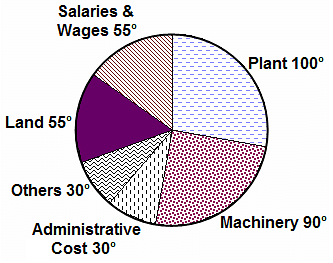
If there is an escalation of 10% in Salaries& Wages and a reduction of 10% in land, what will be the new angle of salaries and wages?
Directions: The question is based on the following pie chart.
Project implementation cost of ABC Ltd. (Rs. Crores)
Total project cost = Rs. 252 Crores
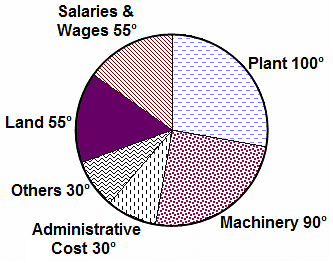
If 5% of administrative costs are reduced and 10% of the remaining administrative costs are transferred to Others category, what is the angle of administrative costs now?
Directions: The following diagrams show the cost price and selling price (in Rs.) of different fruits sold by a fruit vendor.
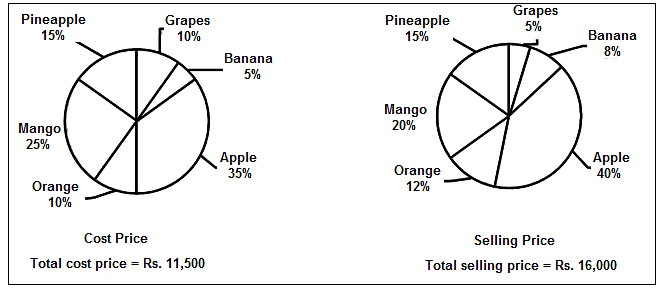
If the selling price of pineapple is increased by 20%, then what is the percentage increase in the total selling price?
Directions: Answer the question on the basis of the pie charts given below.
The following pie charts show the distribution of run scored by Kohli and the Indian team in an innings, considering only the scoring shots.
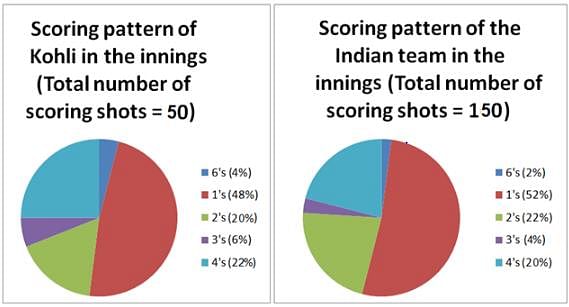
- The balls on which no runs were scored are called dot balls.
- Strike rate of a batsman is the number of runs scored as the percentage of the total number of balls played, including the dot balls.
If the strike rate of the Indian team for this innings was 75%, how many dot balls were played?
The four sentences (labelled 1, 2, 3, 4) below, when properly sequenced would yield a coherent paragraph. Decide on the proper sequencing of the order of the sentences and key in the sequence of the four numbers as your answer:
1. But the attention of the layman, not surprisingly, has been captured by the atom bomb, although there is at least a chance that it may never be used again.
2. Of all the changes introduced by man into the household of nature, [controlled]large-scale nuclear fission is undoubtedly the most dangerous and most profound.
3. The danger to humanity created by the so-called peaceful uses of atomic energy may, however, be much greater.
4. The resultant ionizing radiation has become the most serious agent of pollution of the environment and the greatest threat to man’s survival on earth.
The four sentences (labelled 1, 2, 3, 4) below, when properly sequenced would yield a coherent paragraph. Decide on the proper sequencing of the order of the sentences and key in the sequence of the four numbers as your answer:
1. Each one personified a different aspect of good fortune.
2. The others were versions of popular Buddhist gods, Hindu gods and Daoist gods.
3. Seven popular Japanese deities, the Shichi Fukujin, were considered to bring good luck and happiness.
4. Although they were included in the Shinto pantheon, only two of them, Daikoku and Ebisu, were indigenous Japanese gods.
The four sentences (labelled 1, 2, 3, 4) below, when properly sequenced would yield a coherent paragraph. Decide on the proper sequencing of the order of the sentences and key in the sequence of the four numbers as your answer:
1. It advocated a conservative approach to antitrust enforcement that espouses faith in efficient markets and voiced suspicion regarding the merits of judicial intervention to correct anticompetitive practices.
2. Many industries have consistently gained market share, the lion’s share – without any official concern; the most successful technology companies have grown into veritable titans, on the premise that they advance ‘public interest’.
3. That the new anticompetitive risks posed by tech giants like Google, Facebook, and Amazon, necessitate new legal solutions could be attributed to the dearth of enforcement actions against monopolies and the few cases challenging mergers in the USA.
4. The criterion of ‘consumer welfare standard’ and the principle that antitrust law should serve consumer interests and that it should protect competition rather than individual competitors was an antitrust law introduced by, and named after, the 'Chicago school'.
The four sentences (labelled 1, 2, 3, 4) given below, when properly sequenced would yield a coherent paragraph. Decide on the proper sequence of the order of the sentences and key in the sequence of the four numbers as your answer.
1. People with dyslexia have difficulty with print-reading, and people with autism spectrum disorder have difficulty with mind-reading.
2. An example of a lost cognitive instinct is mind-reading: our capacity to think of ourselves and others as having beliefs, desires, thoughts and feelings.
3. Mind-reading looks increasingly like literacy, a skill we know for sure is not in our genes, since scripts have been around for only 5,000-6,000 years.
4. Print-reading, like mind-reading varies across cultures, depends heavily on certain parts of the brain, and is subject to developmental disorders.
The four sentences (labelled 1, 2, 3, 4) given below, when properly sequenced would yield a coherent paragraph. Decide on the proper sequence of the order of the sentences and key in the sequence of the four numbers as your answer.
1. Metaphors may map to similar meanings across languages, but their subtle differences can have a profound effect on our understanding of the world.
2. Latin scholars point out carpe diem is a horticultural metaphor that, particularly seen in the context of its source, is more accurately translated as “plucking the day,” evoking the plucking and gathering of ripening fruits or flowers, enjoying a moment that is rooted in the sensory experience of nature, unrelated to the force implied in seizing.
3. The phrase carpe diem, which is often translated as “seize the day and its accompanying philosophy, has gone on to inspire countless people in how they live their lives and motivates us to see the world a little differently from the norm
4. It’s an example of one of the more telling ways that we mistranslate metaphors from one language to another, revealing in the process our hidden assumptions about what we really value.
The four sentences (labelled 1, 2, 3, 4) given below, when properly sequenced would yield a coherent paragraph. Decide on the proper sequence of the order of the sentences and key in the sequence of the four numbers as your answer.
1. If you’ve seen a little line of text on websites that says something like "customers who bought this also enjoyed that” you have experienced this collaborative filtering firsthand.
2. The problem with these algorithms is that they don’t take into account a host of nuances and circumstances that might interfere with their accuracy.
3. If you just bought a gardening book for your cousin, you might get a flurry of links to books about gardening, recommended just for you! – the algorithm has no way of knowing you hate gardening and only bought the book as a gift.
4. Collaborative filtering is a mathematical algorithm by which correlations and cooccurrences of behaviors are tracked and then used to make recommendations.
The four sentences (labelled 1, 2, 3, 4) given below, when properly sequenced would yield a coherent paragraph. Decide on the proper sequence of the order of the sentences and key in the sequence of the four numbers as your answer.
1. We’ll all live under mob rule until then, which doesn’t help anyone.
2. Perhaps we need to learn to condense the feedback we receive online so that 100 replies carry the same weight as just one.
3. As we grow more comfortable with social media conversations being part of the way we interact every day, we are going to have to learn how to deal with legitimate criticism.
4. A new norm will arise where it is considered unacceptable to reply with the same point that dozens of others have already.
The four sentences (labelled 1, 2, 3, 4) given below, when properly sequenced would yield a coherent paragraph. Decide on the proper sequence of the order of the sentences and key in the sequence of the four numbers as your answer.
1. To the uninitiated listener, atonal music can sound like chaotic, random noise.
2. Atonality is a condition of music in which the constructs of the music do not ‘live’ within the confines of a particular key signature, scale, or mode.
3. After you realize the amount of knowledge, skill, and technical expertise required to compose or perform it, your tune may change, so to speak.
4. However, atonality is one of the most important movements in 20th century music.
The four sentences (labelled 1, 2, 3, 4) given below, when properly sequenced would yield a coherent paragraph. Decide on the proper sequence of the order of the sentences and key in the sequence of the four numbers as your answer.
1. Living things—animals and plants—typically exhibit correlational structure.
2. Adaptive behaviour depends on cognitive economy, treating objects as equivalent.
3. The information we receive from our senses, from the world, typically has structure and order, and is not arbitrary.
4. To categorize an object means to consider it equivalent to other things in that category, and different—along some salient dimension—from things that are not.
Direction: In each of these questions, in the given sentences, a part of the sentence is underlined. Beneath each sentence, four different ways of phrasing the underlined part are indicated. Choose the best alternative.
If you had told your problem yesterday, we might had helped you
Direction: In each of these questions, in the given sentences, a part of the sentence is underlined. Beneath each sentence, four different ways of phrasing the underlined part are indicated. Choose the best alternative.
A bird in hand is worth two in bush.
Direction: In each of these questions, in the given sentences, a part of the sentence is underlined. Beneath each sentence, four different ways of phrasing the underlined part are indicated. Choose the best alternative.
Manisha purchased the very good of all the saris kept in the shop
Direction: In each of these questions, in the given sentences, a part of the sentence is underlined. Beneath each sentence, four different ways of phrasing the underlined part are indicated. Choose the best alternative.
The actress said that it sometimes took her two hours to put her make -up.
Direction: In each of these questions, in the given sentences, a part of the sentence is underlined. Beneath each sentence, four different ways of phrasing the underlined part are indicated. Choose the best alternative.
Bad habits must be nipped at the bud.
Direction: In each of these questions, in the given sentences, a part of the sentence is underlined. Beneath each sentence, four different ways of phrasing the underlined part are indicated. Choose the best alternative.
What are needed are not large houses but small cottages.
Direction: In each of these questions, in the given sentences, a part of the sentence is underlined. Beneath each sentence, four different ways of phrasing the underlined part are indicated. Choose the best alternative.
Im sorry, but I don’t believe what you say.
|
152 docs|327 tests
|


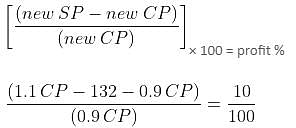



 = Rs. 141.66 per unit
= Rs. 141.66 per unit =
= 
 = Rs. 253/unit (approx.)
= Rs. 253/unit (approx.)















